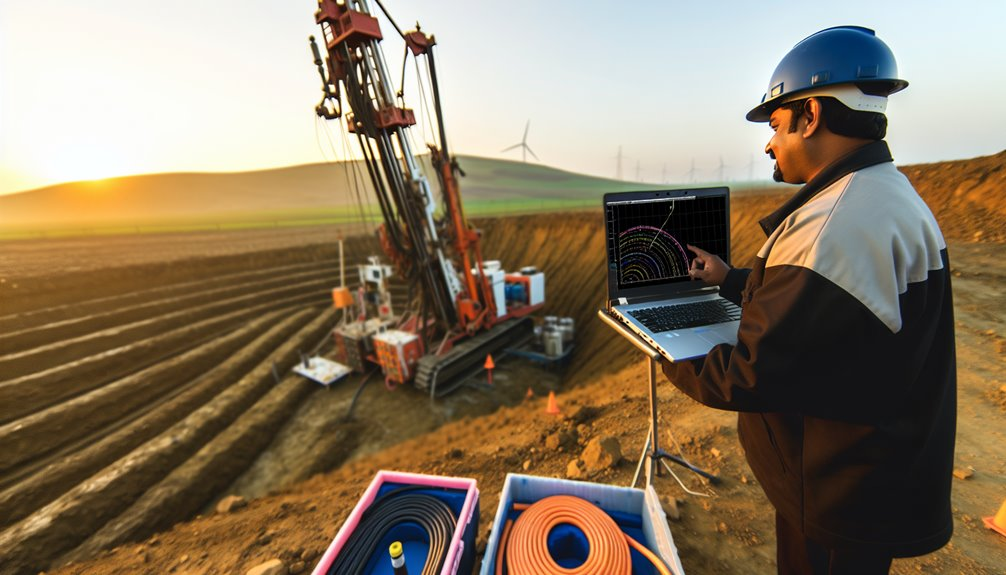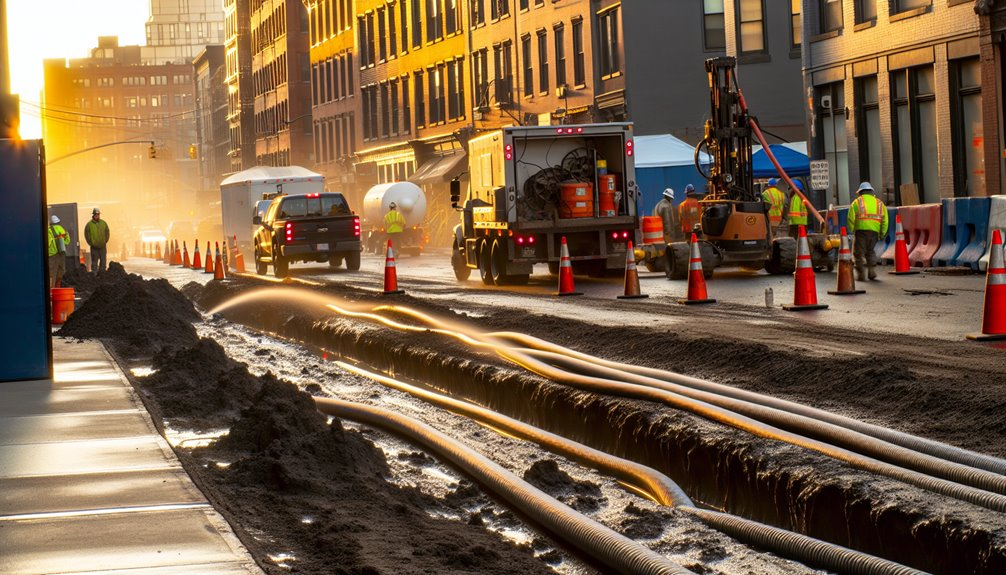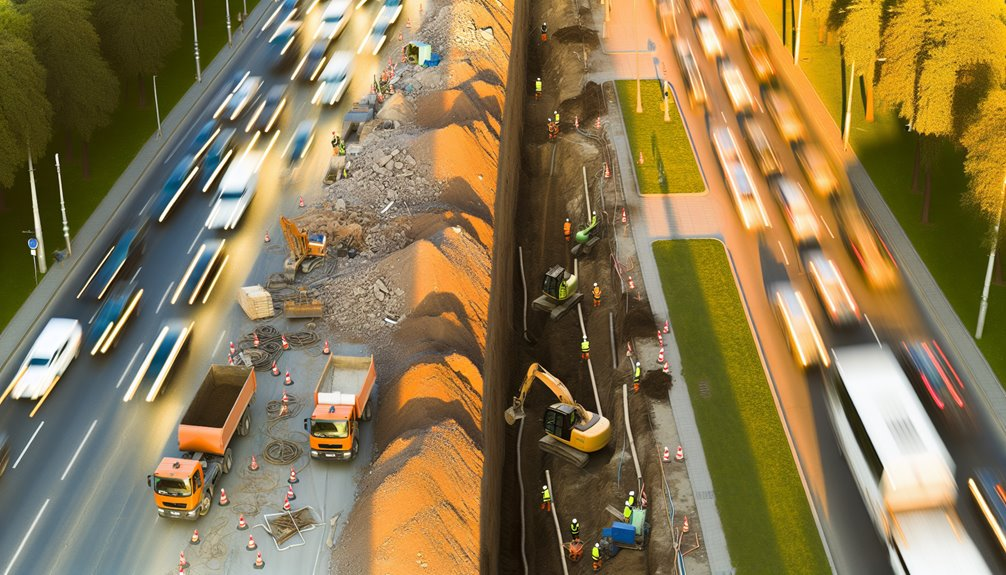When you enlist missile boring contractor services, you're investing in a cutting-edge, precision-driven solution tailored to your project's specific needs. Initially, you'll engage in a detailed consultation where your objectives are mapped against potential geological and environmental challenges. This phase is essential, as it shapes the strategy for minimal surface impact and ideal installation accuracy. Stay tuned to uncover how these initial plans translate into a seamless, efficient drilling process.
Understanding Missile Boring Technology
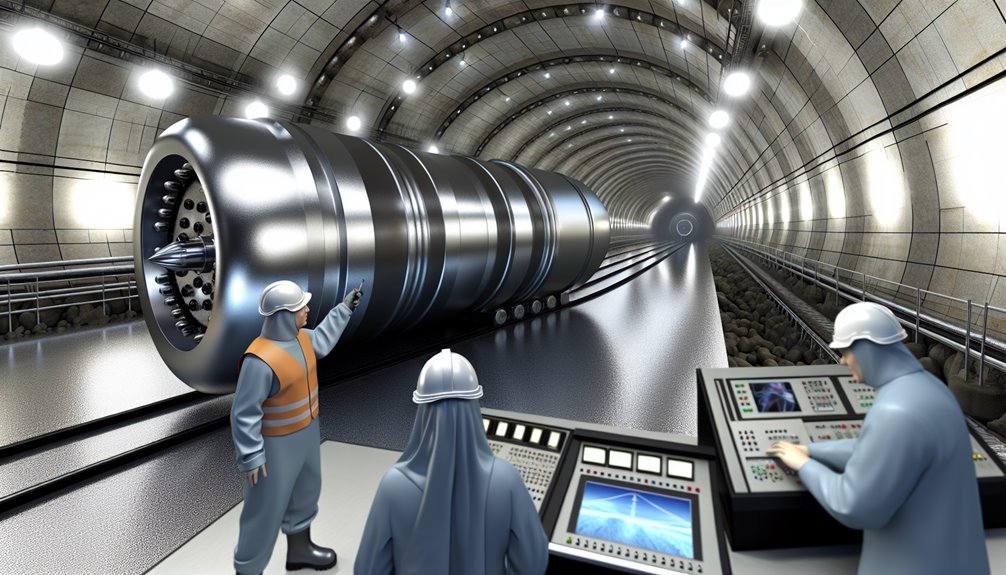
Missile boring technology, often referred to as horizontal boring, underground pneumatic boring, or impact boring, represents a refined method for point-to-point horizontal underground installations.
This approach leverages compressed air to propel a missile-shaped device underground, minimizing surface disruption. It's particularly effective for installing utilities like water, gas, electrical conduits, and communication lines in densely populated or environmentally sensitive areas.
Unlike traditional trenching, the technology allows for quicker installations with markedly reduced environmental footprint. You'll find that the precision of missile boring guarantees minimal soil displacement, which is vital in urban settings. Additionally, the utilization of a trailer-mounted air compressor enables the accurate control of the boring process, enhancing the efficiency of the operation trailer-mounted air compressor.
However, its effectiveness is contingent on soil conditions; it struggles in rocky or unstable terrains. When considering boring technologies for your next project, factor in these missile applications to optimize your approach.
Initial Consultation and Project Planning
How do you initiate a successful missile boring project? It begins with a well-structured initial consultation and project planning phase.
First, you'll need to fill out a request service form detailing your contact information along with the project specifics. This includes the project's name, location, whether it's public or private, and the project owner. This stage is essential for setting clear project objectives.
Define the scope of the project precisely—specify the type of underground installation, such as electrical or oil and gas, and provide details like the casing size and the length.
Stakeholder involvement is integral; discuss all these aspects with all involved parties to align expectations and responsibilities. This meticulous planning guarantees the project's direction is clearly marked from the outset.
For accurate planning, it's important to include soil conditions and water table information as these factors can significantly impact the directional drilling process.
Site Assessment and Preparation
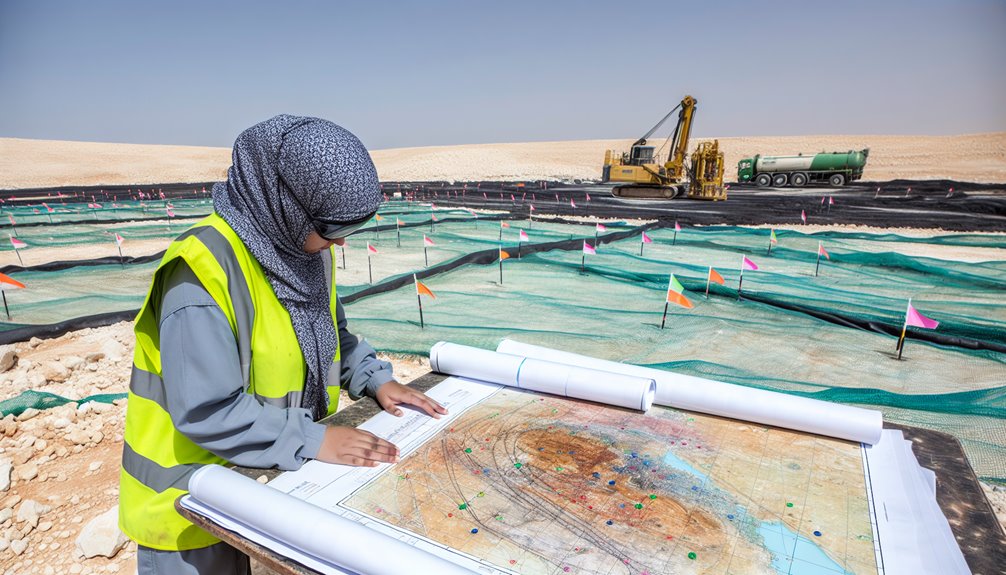
Before you begin missile boring operations, it's essential to perform a detailed soil and terrain analysis to understand the subsurface conditions you'll encounter.
You'll need to establish robust access and safety protocols, ensuring that all pathways are clear and secure for equipment and personnel.
This preparation not only facilitates smoother operations but also greatly mitigates potential risks associated with underground construction.
Soil and Terrain Analysis
To guarantee a successful missile boring operation, conducting a thorough soil and terrain analysis is imperative.
You'll engage in detailed subsurface mapping to identify variations in soil conditions and potential obstacles. Understanding soil compaction levels is vital, as they greatly affect the boring machinery's performance and the structural stability of the bore path.
- Subsurface Mapping: Pinpoints geological inconsistencies, guiding strategic boring locations.
- Soil Compaction Analysis: Determines the mechanical properties of the soil, essential for adjusting drilling parameters.
- Geotechnical Testing: Involves rigorous laboratory tests to assess soil strength and infiltration capacities, ensuring the design accommodates subsurface realities.
This all-encompassing approach minimizes unforeseen challenges, enhancing both safety and efficiency in your project's execution.
Access and Safety Protocols
Guaranteeing safe access and meticulous preparation of the worksite, your team must conduct regular safety audits and adhere to rigorous Job Safety Analysis (JSA) procedures, reviewed daily.
You'll need to integrate geologic surveys and detailed sampling to accurately assess underground conditions, essential for anticipating challenges.
Additionally, systematic identification of task-related hazards through Hazard ID tools guarantees all potential risks are addressed before they escalate.
Protocol implementation is pivotal; maintaining clear access and egress routes, securing unused openings, and enforcing robust ground support protocols safeguard personnel and equipment.
The Drilling Process Explained
You'll begin by meticulously preparing the site, where each step, from the excavation of the entry pit to guaranteeing all safety measures are in place, is critical for a successful bore.
Advanced drilling techniques then come into play, utilizing a high-powered air compressor and a percussive missile to navigate through the soil with precision.
Post-drilling, a thorough analysis guarantees the bore path is correctly aligned and ready for utility installation, with each phase documented for accuracy and compliance.
Site Preparation Steps
Before initiating the drilling process, meticulous site preparation is essential to guarantee safety and efficiency.
First, utility mapping is vital. Use technologies like Ground Penetrating Radar (GPR) and Electromagnetic Induction (EMI) for precise detection of subsurface utilities. Mark and expose them using innovative hydro-excavation techniques, ensuring you visually verify their depth and orientation.
- Utility Location and Marking: Employ advanced detection methods to minimize disruption to existing services.
- Site Survey and Planning: Analyze site conditions meticulously, documenting all relevant data and potential hazards.
- Equipment Setup and Staging: Prepare your site to support heavy machinery while ensuring operational safety and environmental compliance.
These preparatory steps lay the groundwork for a successful drilling operation, integrating safety with cutting-edge practices.
Advanced Drilling Techniques
To understand the mechanics of missile boring, it's essential to first grasp the unique process that defines this drilling technique.
Advanced techniques in missile boring employ an air-powered percussion tool, which utilizes a massive weight to generate a reciprocating action. This weight, driven by high-pressure air, punches through soil with precision. Despite its non-steerable nature, this method's efficiency shines in dry soils and for installations requiring minimal environmental disruption.
Drilling innovations extend to the equipment used, such as trailer-mounted air compressors and sophisticated oil systems that guarantee sustained tool performance.
The introduction of progress pits every 40-60 feet allows for extended bore paths, vital in urban or environmentally sensitive areas, thereby marrying efficiency with practical environmental stewardship.
Post-Drilling Analysis
Once the missile boring process concludes, an extensive post-drilling analysis begins, integrating real-time data to refine and validate the drilling operations.
You'll explore advanced data interpretation and drilling optimization techniques that are essential for enhancing future projects.
- Real-Time Data Integration: Immediate use of geological data allows for dynamic adjustments to the drilling trajectory, optimizing operational efficiency.
- Validation and Refinement: Post-drilling validation confirms the accuracy of the well path, enabling precise adjustments and future well placements.
- Reservoir Characterization: Detailed analysis of rock and fluid properties post-drilling influences decisions on reservoir management, improving long-term outcomes.
These steps guarantee that each missile boring project not only meets but exceeds expectations, paving the way for innovative advancements in drilling technology.
Timeline and Phases of Installation
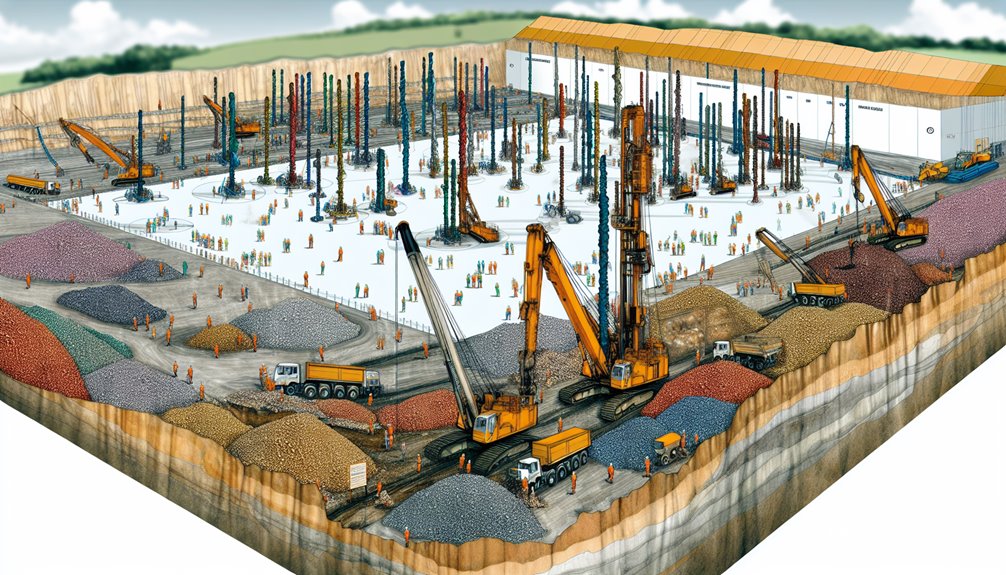
Understanding the timeline and phases of installation for missile boring projects is vital for achieving efficiency and precision. Initially, drilling the pilot hole involves precise directional navigation, using an electronic transmitter to maintain the designated path. This first phase sets the stage for subsequent steps, significantly impacting timeline visualization.
Next, pre-reaming enlarges the borehole to accommodate the pipeline, incorporating multiple passes to guarantee structural integrity. This phase includes meticulous planning of installation milestones, critical for meeting project timelines.
During pullback operations, the pipeline is connected and pulled through the borehole, requiring rigorous coordination of drilling fluids and pipe handling mechanisms to mitigate risks.
Finally, conduits are installed and tested, confirming the operational success and precise placement vital for the project's conclusion.
Cost Breakdown and Budgeting
Breaking down the costs and budgeting for missile boring projects involves multiple variables that directly impact the financial planning of such operations.
You'll need a thorough approach to cost estimation and effective budget management to guarantee project success.
Here's what to take into account:
- Equipment and Machinery: This includes upfront capital costs for tunnel boring machines and ongoing expenses like maintenance and cutter replacement.
- Labor and Crew: Factor in the costs for mobilizing crews, paying skilled labor rates, and potential overtime.
- Project-Specific Costs and Savings: Minimal restoration post-installation saves greatly on rehabilitation expenses.
Each component requires careful analysis to avoid budget overruns.
Staying ahead in cost management guarantees your project remains financially viable and innovative.
Environmental Considerations and Impact
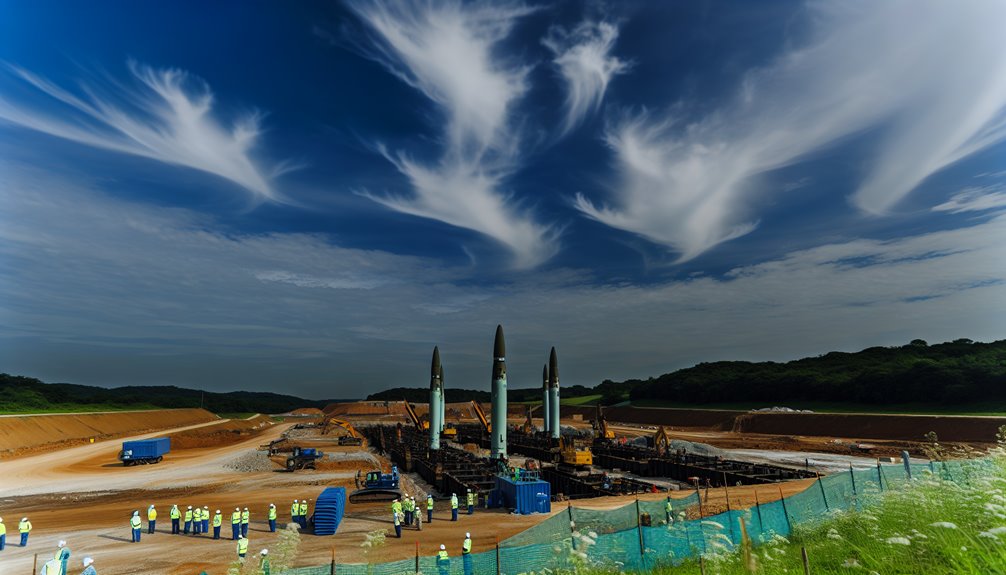
While drilling operations are essential for infrastructure development, they pose significant environmental risks that require careful management to mitigate impacts on ecosystems and water quality.
You must be vigilant about the interconnection of groundwaters, as different water qualities can introduce contaminants into pristine aquifers.
The utilization of Bentonite-based drilling muds, which are inorganic and non-biodegradable, necessitates innovative handling techniques to minimize ecological disturbances.
Adherence to environmental regulations is non-negotiable; you're expected to document all chemical compositions and guarantee that drilling innovations like grout additions or surface casing installations are employed to effectively seal boreholes.
This proactive approach not only preserves water quality but also safeguards aquatic and terrestrial ecosystems from the adverse effects of inadvertent returns and chemical leaching.
Post-Installation Review and Maintenance
After addressing environmental considerations during the missile boring process, it's imperative to focus on post-installation review and maintenance to confirm long-term success and functionality.
Thorough inspection and documentation are critical. Here's what you should expect:
- Inspection and Verification: Verify all utility lines are correctly placed and fully operational. Utilize soft dig techniques to confirm no interference with existing utilities.
- Restoration and Backfilling: Methodically backfill access pits and restore the landscape, maintaining the site's original aesthetics and stability.
- Continuous Feedback Loop: Regularly gather and analyze resident feedback to refine practices and enhance customer satisfaction. Maintain detailed post-installation documentation for accountability and continual improvement.
These steps are essential for sustaining the integrity of the installation and fostering innovation in future projects.
Conclusion
As you wrap up your missile boring project, expect a precise conclusion. The contractor will meticulously review all phases, ensuring every aspect meets your specifications and industry standards. You'll receive detailed documentation for your records, highlighting the accuracy and efficiency of the installation. Continuous support post-installation guarantees operational excellence. Remember, this technology not only meets your immediate needs but also minimizes environmental impact, aligning with sustainability goals.
If you're curious to learn more about our services or have any questions, feel free to visit us at Boring Bros by going to boringbro.com. You can also give us a call at (954) 639-6167. We're here to help you every step of the way, and we'd love to chat!

